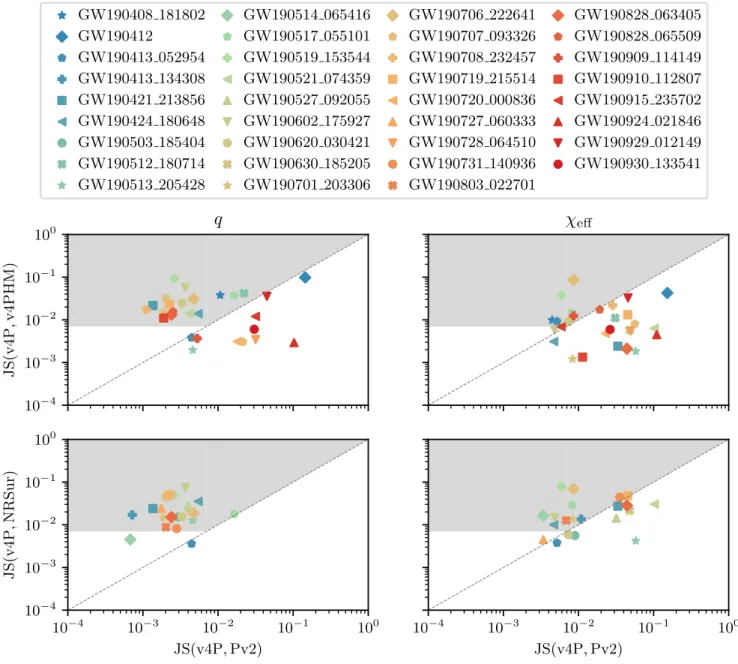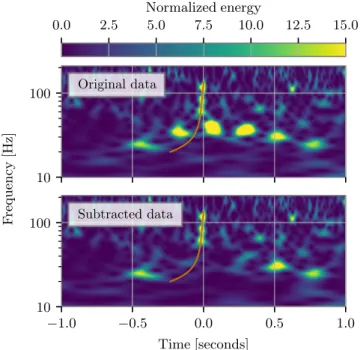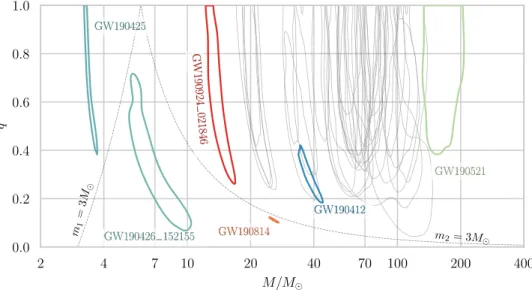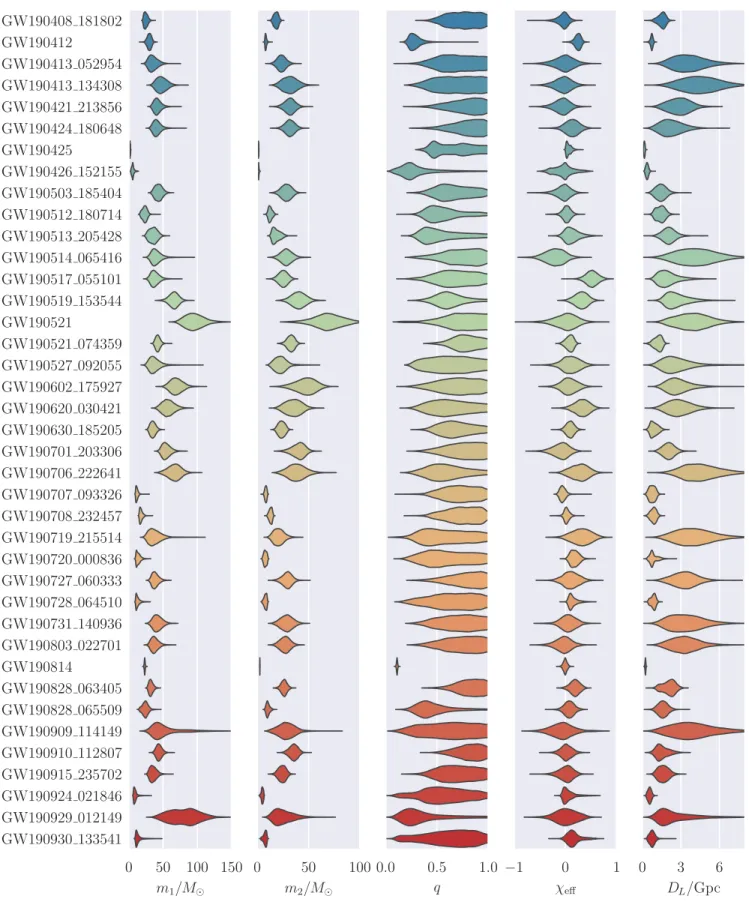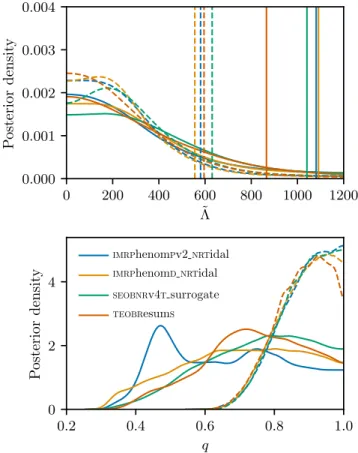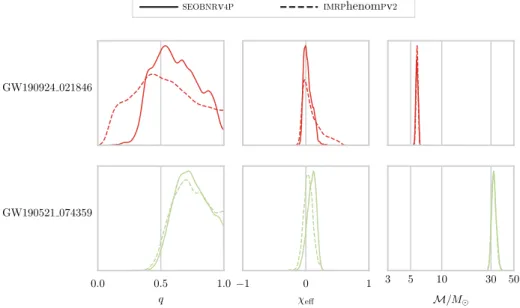Another upgrade to improve low-frequency sensitivity is the suspension of the external injection bench (used to manipulate and steer the input laser beam into the interferometer). The clamping technique used by LIGO to improve the high-frequency sensitivity of the detectors is also implemented in the Virgo interferometer[61]. These studies are part of ongoing efforts to improve data quality and detector uptime [40,82].
These procedures do not identify evidence of an instrumental origin for any of the possible events in this catalog, but they do identify many Figs. In both plots, the time-frequency trace of the matched filter template used to identify GW190701_. The matched filter method is based on a signal model that depends on the source physical parameters.
Evaluation of modeled search sensitivity In order to evaluate the sensitivity of GstLAL and.
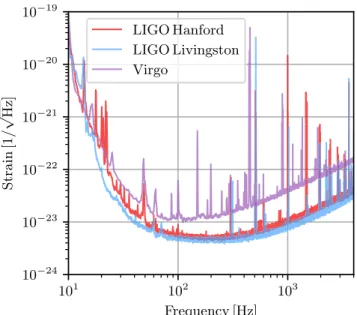
ESTIMATION OF SOURCE PARAMETERS Once triggers of interest are identified, the physical
GW, a candidate NSBH event of low significance, is reported with low latency [174]; however, its astrophysical probability is highly dependent on previous assumptions about the speed of such signals. We do not calculate terminal masses and spins when including matter effects in the analyses, because this calculation requires an accurate prediction of the ejected mass after possible tidal disruption, taking into account the equation of state and uncertain details of the merger dynamics. SEOBNRv4P [157,199] is based on the effective-one-body (EOB) formalism[200,201] and calibrated to NR, with a generic two-spin treatment of the precession dynamics.
Both models contain a phenomenological description of the tidal effects introduced on NR simulations[224] and include corrections to the amplitude through inspiration, coalescence and shutdown to account for a possibility of tidal disruption. Table III shows the waveforms used in this work, the keys under which we group results using these waveforms, and descriptions of the physical effects included in the models. We use LAInference's nested sampling algorithm for most of the BBH analyzes performed with the IMRPhenomD and.
Each event is analyzed independently using a prior distribution on the source parameters that is chosen to ensure adequate sampling of the parameter space and simplicity in using posterior samples for further analysis.
CANDIDATE EVENT LIST
However, the candidate event is not observed at low latency or offline by GstLAL, PyCBC or cWB as significant. Incorporating iDQ data quality into the event sequence, combined with tuning the signal consistency tests to further reject the O3a defect background, improves the sensitivity of the offline GstLAL assay to candidate events with a single detector compared to the setup with low latency, which accounts for these new discoveries. Some of these discoveries have been observed at low latency, but do not meet the criteria for publication.
Offline analyzes here differ from their low-latency counterparts by having improved template banks, improved use of data quality information, improved data calibration, data cleaning, and improved tuning to reject nonstationary noise background observed in O3a. The Livingston detector is more problematic for low-latency analyzes than in previous observational runs with the noise defect rate being significantly higher than in O2 (see Sec.III B). Low-latency detection, especially for candidate events coming from only one interferometer, is particularly challenging during O3a.
Although this misidentification can also affect candidates observed in multiple interferometers, single-detector candidates are particularly susceptible to new low-latency noise sources seen for the first time.
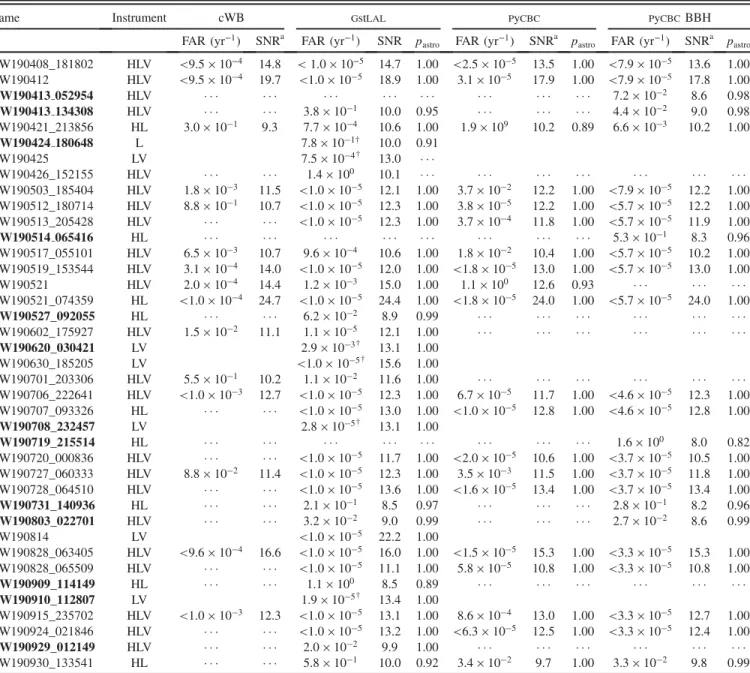
SOURCE PROPERTIES
The full list of candidate events using candidate-specific reduction, along with the constraint configuration, is provided in Table V. Based on the studies described in Appendix A, we find that most gravitational wave candidate events in this catalog exhibit small changes in source parameter estimates when spherical harmonic modes above1¼2 are included. However, these differences in aggregate can still affect population-level studies, so we present as reliable results the combined posterior samples of HM runs for all BBH candidate events except GW GW190720_.
IMRPhenomPv3HM or NRSur7dq4, so here we present the HM results for these candidate events as reliable results and refer readers to these publications for details on these candidate events [261]. To identify the candidate events with the most extreme parameter values, we repeatedly randomly select one posterior sample from each event and record which candidate events have the lowest and highest values of each parameter. To provide an overview of the posterior distributions of source parameters for all GWTC-2 candidate events, we show the 90% credible regions for all candidate events in the M-q and M-χeff planes in Figs 6 and 7 and the corresponding one-dimensional marginal posterior distributions on m1, q and χeff in fig.
Here we describe the masses for candidate events with m2>3 M⊙, which we can confidently expect to be BBHs. Credible region contours for all candidate events in the total mass and mass ratio planeq. Credible region contours for all candidate events in the chirp-mass plane and effective inspiring spinχeff.
We highlight previously published candidate events (cf. Fig. 6), as well as the GW and GW most likely to have the largest and smallest χeff, respectively. Marginal posterior distributions of primary mass m1, secondary mass m2, mass ratioq, effective inspiratory spinχeff and luminosity distance dL for all candidate events in O3a. In some cases, measuring the total χeff and mass ratio for an event provides a more accurate measurement of the spin magnitude of the primary mass than for candidate events with mass ratios closer to unity.
The posterior distributions of spin magnitudes and tilt angles are shown in Fig. 10 for these two event candidates and other selected systems exhibiting non-zero spins. With candidate events at these cosmological distances, we can more easily measure the Hubble constant and the evolution of the BBH merger rate over cosmic time.
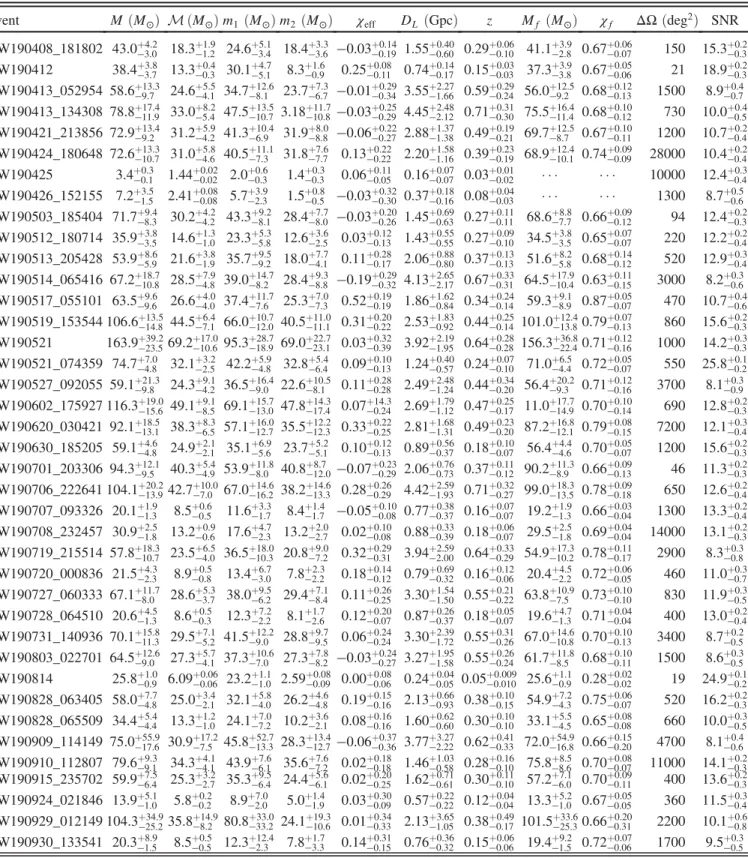
WAVEFORM RECONSTRUCTIONS Template-based [179,286] and minimally modeled meth-
Probability density sky maps for all events are available as part of the data release [262]. Minimally modeled reconstructions make it possible to discover unexpected phenomena, but do not provide a direct picture of the physical properties of the source. The currently available waveform templates for binary mergers are based on various approximations and numerical solutions of Einstein's equations covering a subset of the entire parameter space.
One way to test these scenarios is to compare the template-based and minimally modeled waveform reconstructions. For each event, the matches are calculated between the maximum likelihood template-based waveforms and two minimally modeled waveform reconstruction methods, cWB [112] and BW [107], using data representing the FIG. The cWB analysis includes the candidate events that are both detected and reconstructed (listed in Table IV ) and those that are detected but reconstructed offline.
The BW analysis uses the same selection of BBH candidate events as used for testing general relativity [ 36 ]. Each pvalue is obtained from the observed on-source fitting value and the corresponding off-source distribution of the fitting values of off-source injections. A few of the cWBp values are above the band, indicating either a statistical fluctuation or an overfitting, which we attribute to a small asymmetry between the way the on-source and off-source fits are calculated.
Minimally modeled waveform reconstructions are repeated several times on these out-of-source data to estimate the distribution of match values we would expect for each event. For each event, these distributions are used to calculate a p-value, given by the fraction of out-of-source match values that are below the in-source match. For some of the lower SNR candidate events, the minimally modeled methods are unable to reconstruct the signals and these candidate events are excluded from the analysis.
Our tests also indicate that if there is indeed a systematic effect, it may stem from an overestimation of off-source matches that is no larger than 2%. Overall, the p-value distribution supports the null hypothesis that the minimally modeled waveform reconstructions are consistent with the general relativity-derived waveform templates.
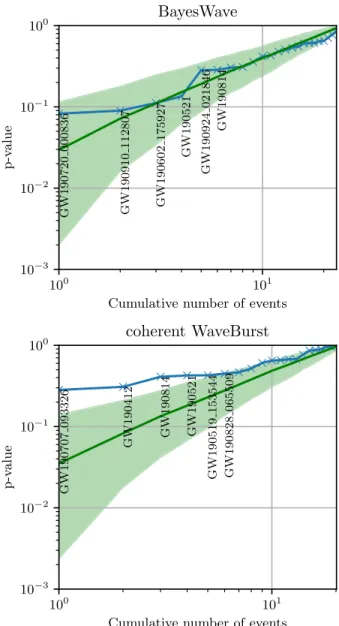
CONCLUSION
Abbottet al. (LIGO Scientific Collaboration, Virgo Collaboration, 1M2H, Dark Energy Camera GW-E, DES, DLT40, Las Cumbres Observatory, VINROUGE, MASTER), A Gravitational-Wave Standard Siren Measurement of the Hubble Constant, Nature (London Abbottet al .(LIGO Scientific Collaboration, Virgo Collaboration), A gravitational wave measurement of the Hubble constant after the second observation run of Advanced LIGO and Virgo, Astrophys. Virgo Collaboration), Calibration of advanced Virgo and reconstruction of the gravitational wave signal hðtÞduring the observation run O2, classical quantum gravity.
Abbott et al. (LIGO Science Collaboration, Virgo Collaboration), Characterization of transient noise in advanced LIGO relevant to the GW150914 gravitational wave signal, Classical Quantum Gravity. Savage, Precision-enhanced fiducial shifts for a global network of gravitational wave detectors, Classical Quantum Grav. Pankow et al., Transient reduction of instrumental noise in gravitational wave data around GW170817, Phys.
Messick et al., Analysis Framework for the Prompt Discovery of Compact Binary Mergers in Gravitational Wave Data, Phys. Klimenko et al., Method for detection and reconstruction of gravitational wave transients with networks of advanced detectors, Phys. Wang, Low-Latency Analysis Pipeline for Compact Binary Coalescences in the Advanced Gravitational Wave Detector Era, Classical Quantum Gravity.
Abbottet al.(LIGO Scientific Collaboration, Virgo Collaboration), All-Sky Search for Short Gravitational- Wave Bursts in the Second Advanced LIGO and Advanced Virgo Run,Phys. Abbottet al.(LIGO Scientific Collaboration, Virgo Collaboration), Observing Gravitational-Wave Transient GW150914 with Minimal Assumptions,Phys. Ohme, Fenomenologiese Model vir die Gravitasie-golfsein van die voorafgaan van binêre swart gate met twee-spin-effekte, Phys.
Hannam, Including higher order multipoles in gravitational wave models for pre-binary black holes, Phys. Lange et al., Parameter Estimation Method Directly Comparing Gravitational Wave Observations with Numerical Relativity, Phys. Ashton et al., BILBY: A User-Friendly Bayesian Inference Library for Gravitational-Wave Astronomy, Astrophys.
Cornish, Reconstructing gravitational wave signals from binary black hole mergers with minimal assumptions, Phys. Wysocki, Impact of subdominant modes on the interpretation of gravitational wave signals from heavy binary black hole systems, Phys. Nitz, Template banks to search for low-mass binary black holes in advanced gravitational wave detectors, Phys.
